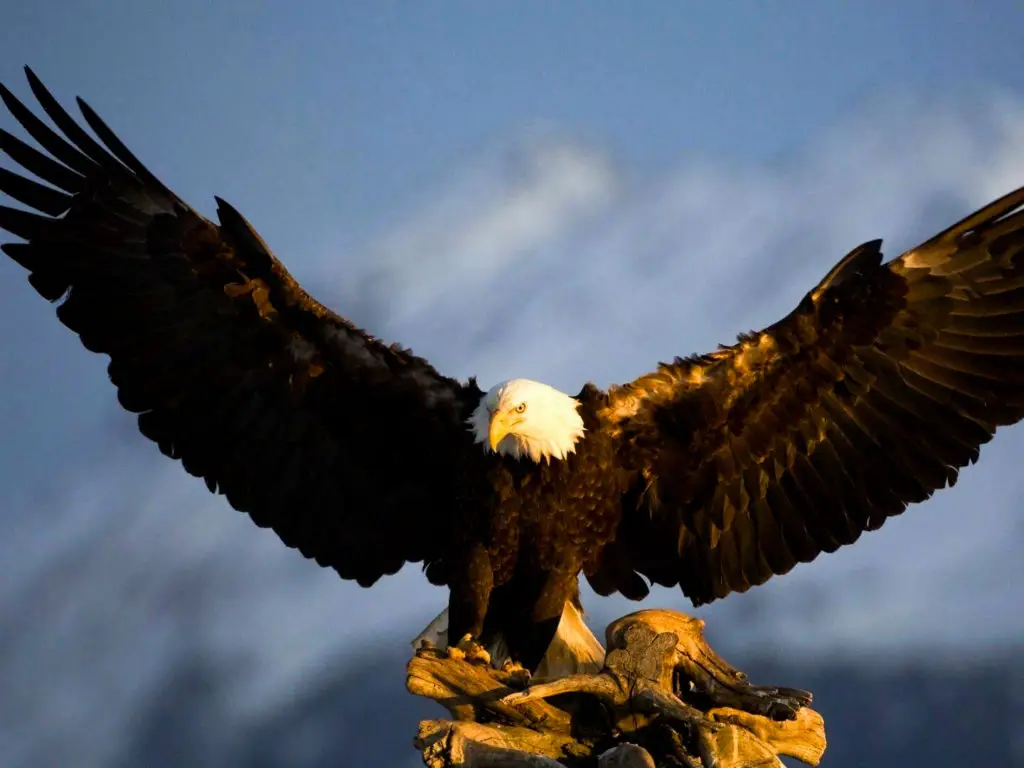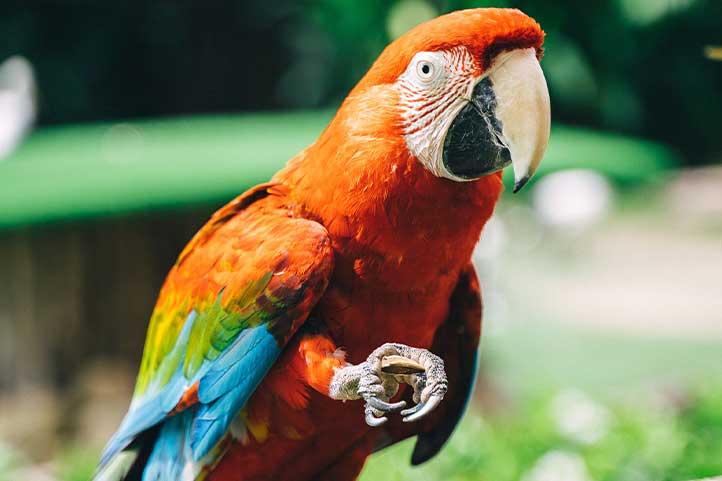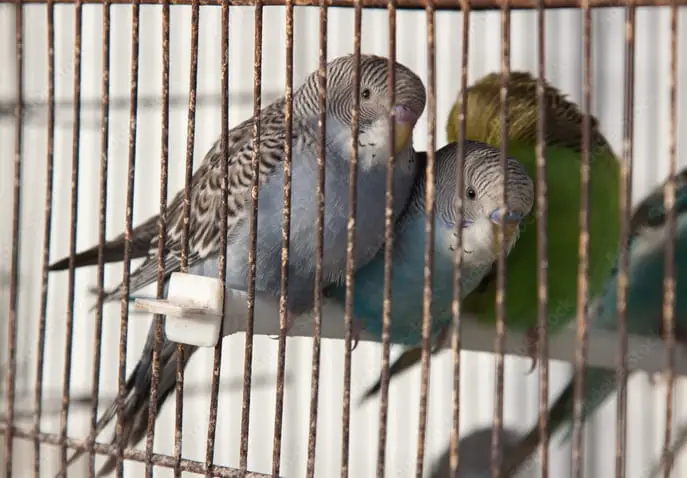Translated by Nick R
Birds of prey are spectacular animals known for being great predators and holding their place on the throne of the animal kingdom. Now, exotic bird enthusiasts may wonder, is it a good idea to have an eagle as a pet? If you’re dying of curiosity, find out below.
Table of Contents
About birds of prey
Origin of birds of prey
Birds of prey are known to be excellent hunters and sit atop the food chain. Yes, it’s true that they are feared predators for having dangerous beaks and powerful talons with which they catch their prey giving them no chance to escape. So far, I guess you don’t really fancy the idea of having one of them as a pet. But, don’t panic, wait! Read on.
Raptors, or birds of prey as they are also called, group all birds that hunt and feed on other animals (including insects). These flying animals, masters of the skies and top predators evolved to hunt various types of prey with high precision from the sky.
How are these birds classified?
Like most modern bird species, birds of prey belong to the large group or superorder of neo-birds or new birds, including the species groups of Psittaciformes (parrots) and Columbiformes (pigeons). However, the diurnal raptors or Falconiformes are not part of the same family line (evolutionary) as the nocturnal raptors or Strigiformes. That is, they don’t share one common ancestor, but rather their similarities are the result of evolutionary convergence, so they come from different families but have the same characteristics and behavior.
Types of birds of prey
Diurnal birds of prey
Birds of prey have different life habits, either diurnal or nocturnal. Raptors that like to hunt and carry out their activities during the day, taking advantage of the sunlight, are called diurnal raptors (Falconiformes), among them, we find species such as eagles, hawks, falcons and the new-world vultures (such as the condors).
Among the diurnal raptors, the following species are the most representative:
- Golden eagle.
- Bald eagle.
- Harpy eagle.
Nocturnal birds of prey
On the other hand, birds of prey that prefer nighttime for their survival activities are called nocturnal birds of prey (Strigiformes), and include the owls. Species within this group have evolved to live in the dark, with eye adaptations to better perceive light in the darkest times of the day.
Some representative species of nocturnal raptors are:
- Eurasian eagle owl.
- Short-eared owl.
- Pygmy owl or owlet.
Important
Now, if you would ask me, what is the best option among so many options? I would say that the diurnal species include the Accipitridae (eagles) and Falconidae (hawks), while the nocturnal species include the family of Strigidae (owls).
What is falconry?
Falconry is the practice of taming birds of prey, implemented as a sport, in which humans take advantage of the hunting skills of eagles and hawks to train them for tournaments or competitions among falconers (those who are dedicated to the sport). Breeders became one with the animal and used it to hunt other animals. It’s a discipline with more than 4,000 years of antiquity and had its apogee among the European nobility of the Middle Ages.
Nowadays, these birds are trained for other types of events, showing rather the breeder’s skill in dominating the bird than the animal’s hunting ability. Falconry has also been used as the basis for the modern domestication of these birds, which are raised as pets. Modern falconry has its foundations in the work of the naturalist and popularizer, Felix Rodriguez de la Fuente.
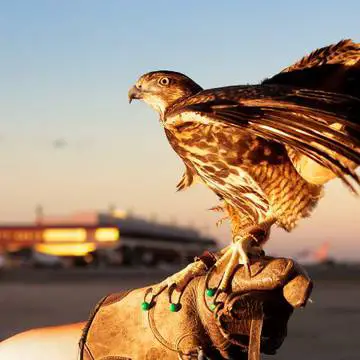
No doubt they are great animals. Do you want one?
Are birds of prey permitted as pets?
Birds of prey are not everyone’s pet of choice, nor are they the trendiest of pets. But, they are amazing animals that many people with sufficient expertise would like to have. Of course, there are regulations on the keeping of exotic animals, in this case, eagles, owls or hawks, which have been protected for several decades in most countries due to the decline of their populations in the last century.
They have not always been protected by humans; there was a time when they were considered destructive vermin and were systematically persecuted and exterminated by the government itself, as was the case during Franco’s dictatorship in Spain until the 60s and 70s when legislation to protect them was enacted. Additionally, pollution, pesticides, habitat destruction, and the reduction of the prey population caused the decline of many raptor species.
According to the legislation of the country and the Convention on International Trade in Endangered Species of Wild Fauna and Flora (CITES), you, as a private individual, can keep a bird of prey as a pet, but only when you have demonstrated the adequacy of the facility where the bird is to live. If you don’t comply with the requirements of the environmental institutions in charge, you won’t be able to keep a bird of prey as a “pet”.
A bird of prey can be adopted only in a specialized center, where you are given a certificate of ownership after verifying that you count with adequate conditions to keep the bird.
Is it madness to keep birds of prey as pets?
Usually, I would say it is a crazy thing to have birds of prey as pets as they are not very sociable or affable birds. However, when it comes to adopting these birds, it’s a different story. Although totally different from the others, we can raise raptors by ourselves through the training techniques inherited from falconry, still in use today.
I know they are not ordinary pet birds, but a different way of conceiving the keeping of a bird under a special condition. Obviously, it cannot live in your apartments like a cat or a parrot, but you can indeed adopt one. Throughout this article, we will refer to it as a pet, just for the sake of practicality and to avoid ambiguities.
Birds of prey are very demanding pets because they require permits as you have read and certain conditions regarding environment, training and feeding. If you have the knowledge and have acquired some experience in falconry, it could be an excellent option, otherwise, I would not advise you to adopt a raptor.
The best birds of prey to have as pets are eagles (diurnal) and owls (nocturnal). Having an eagle or an owl is not easy, so let me show you some of the pros and cons for you to make the best decision.
3 reasons to have birds of prey
- High intelligence level and high capacity to learn through training.
- Unique pets, you will never find a pet just like a bird of prey. Birds of prey can become a source of wildlife wisdom.
- Birds of prey are not affectionate or sing beautifully, but they are very loyal when they find a suitable trainer, generating a special bond that makes the owner and the animal one.
3 reasons not to keep birds of prey
- They require a lot of space and time, so if you live in the city or in a residential home, I don’t recommend having a bird of prey.
- They are expensive birds. Actually, if you compare the care of a parrot and an eagle you’ll realize that the requirements for keeping a bird of prey are higher than for any pet bird.
- Without proper training, they can be a bit belligerent and aggressive.
Characteristics and behavior of raptors
| Scientific name | Falconiformes |
| Common name | Diurnal birds of prey |
| Place of origin | All over the world |
| Habitat | All environments |
| Size | 40 – 90 cm |
| Weight | 220 g – 8000 g |
| Average sexual or reproductive age | Between 4 and 5 years. |
| Life expectancy in captivity | Between 30 and 40 years. |
Diurnal raptors are distributed all over the world, mainly in the neotropics. Thanks to their great capacity to adapt to a variety of biomes, the only areas where you won’t find this cosmopolitan birds are the Antarctic and the small islands of the Pacific (Polynesia, among others). In the particular case of eagles, they are most widely distributed in Eurasia.
Most diurnal birds of prey measure on average from 40 to 90 centimeters and can weigh from 220 grams to as much as 14 kg: as is the case of the largest species, which reach up to one meter in length. However, on average, the body mass of these birds ranges between 2 and 7 kilograms.
Eagles are long-lived birds that in the wild live up to 25 years, although in captivity with good care they can live up to 40 years.
Now, let’s take a look at the characteristics of the “lords of the night”.
| Scientific name | Strigiformes |
| Common name | Nocturnal birds of prey |
| Place of origin | All over the world |
| Habitat | All environments |
| Size | 50 – 80 cm |
| Weight | 250 g – 5000 g |
| Average sexual or reproductive age | Between 2 and 3 years. |
| Life expectancy in captivity | Up to 50 years. |
Now let’s talk about nocturnal raptors, animals with a wide distribution all over the world, except in Antarctica, remote islands, and most of Greenland. Like diurnal raptors, nocturnal birds of prey were able to conquer diverse types of environments and spread across five continents.
Owls vary from 50 to 80 centimeters in size with an average body mass between 1.5 and 4 kilograms. Of course, there is always the exception and, among owls, there are species such as the western Siberian eagle owl (Bubo bubo sibiricus), which measures up to 190 centimeters (females).
Owls, on the other hand, can be very long-lived, with a life expectancy of up to 50 years with proper care. Birds of prey are pets for life.
Appearance of birds of prey
As you have seen, raptors comprise a great variety of species that, although share many characteristics, they also have their own particularities. Therefore, I’ll show you here the general characteristics that identify them in general terms.
Impressive vision
Well, for most people it’s no secret the great vision of these animals, who can fly at a great height and speed, while with their incredible eyes they detect their prey more than 1 km away. This is because they have special eyes, capable of seeing from long distances with their binocular vision through a highly focused field of vision and magnifying lens (crystalline lens), which adapts to different focal distances and is known as “avian eye”.
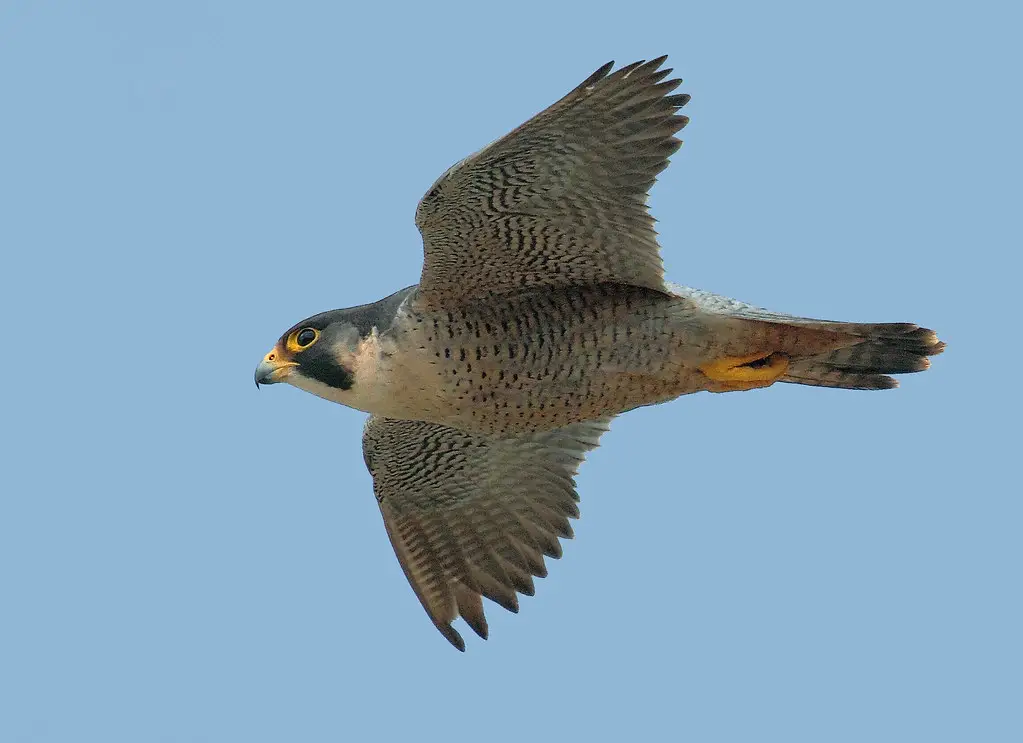
Powerful claws
The claws of raptors are naturally designed to catch and not let go. They have fingers and nails made to catch a variety of prey with such precision that the probability of failure is very low. A prey that has been caught by a raptor is destined to die (sounds cruel, but it’s true).
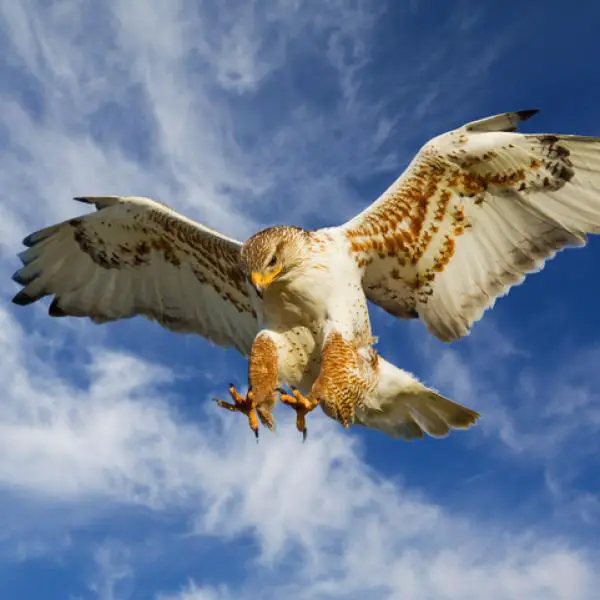
Deadly beak
The beak of raptors is a deadly weapon for hunting their prey, capable of shredding and tearing flesh easily. The beak of these hunters is curved and sharp, each species with its own design, but with a single purpose: to kill.
They are the same but different…
Females and males have no obvious differentiation or what is scientifically called dimorphism. Both eagles and owls, sexually speaking, are monomorphic (male and female physically the same). The main difference between the two comes down to size, with the female being larger than the male, approximately 25-30% larger.
Now let’s take a closer look at one model for each type of raptor.
What does an eagle look like?
Eagles have particular physical features that distinguish them from other birds of prey, such as:
- More streamlined and compact bodies.
- Fixed gaze and eyes proportionate in size to its head.
- The beak is oriented forward and curved at the end.
- Legs completely covered by feathers up to the toes.
- Legs with an anisodactyl distribution of toes (three toes forward and one backward).
- Very long and wide wings in relation to its body to hover and take advantage of vertical air currents.
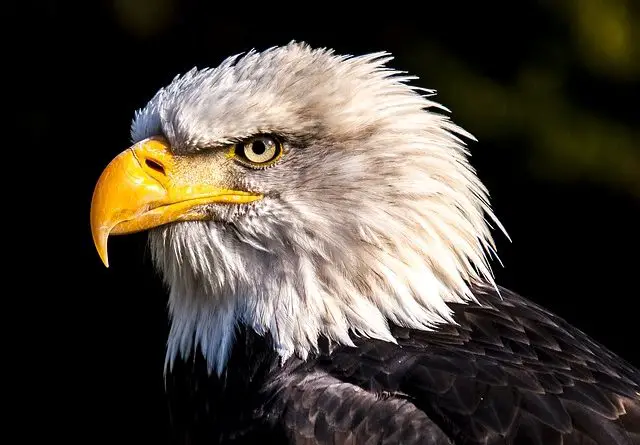
What about hawks?
Ok. In another article, we’ll talk about hawks in more depth.
What does an owl look like?
Owls are distinguished by several particular physical characteristics, including:
- Very large, luminous eyes – unmistakable!
- Round, robust bodies with dense plumage.
- The Head is flattened on its vertical axis and broad horizontally.
- Small and curved beak.
- Recognized for their acute hearing, anatomically designed with super power.
- Feathers are ruffled on the sides of the head (main difference with owls).
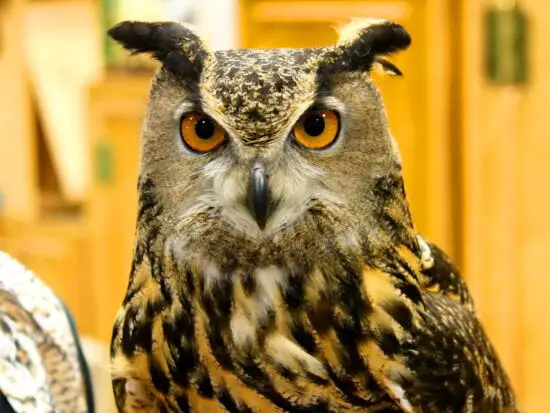
What do vultures look like?
- They have bald heads.
- Pointed beaks.
- Long, curved necks.
- A really wide wingspan.
- Horizontally elongated head.
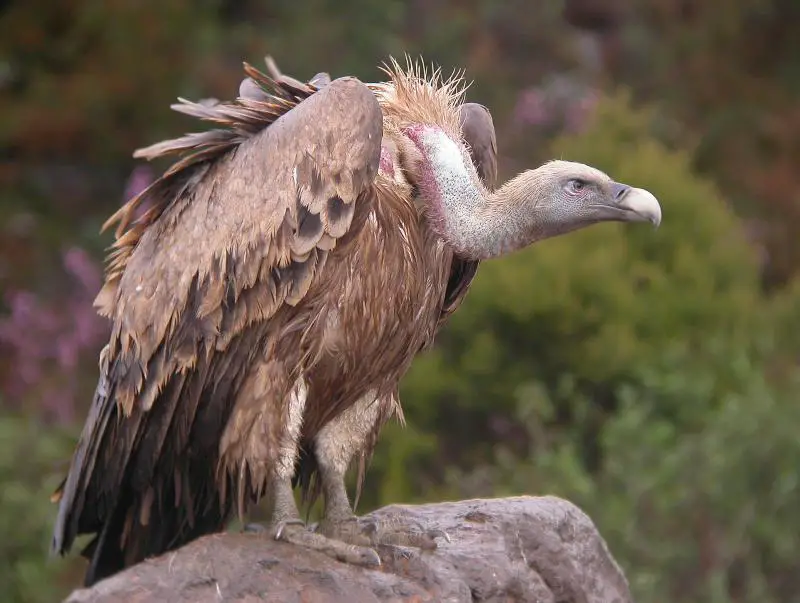
Wild behavior
Birds of prey are top predators and behave in a brusque and territorial manner, spending most of their time alone. In their natural habitat, they can be seen always in the air, watching from the skies vigilantly, prepared to engage in the pursuit of their prey. Whenever you see a bird of prey, you’ll see it perched in a tree or other place, all alone. This is mainly because they have small populations and require a hunting area of their own to survive.
Birds of prey are monogamous animals, they are very faithful and share their lives with only one partner, the same one with whom they reproduce every time the mating season arrives. Reproduction in raptors takes place in three stages: courtship, copulation (internal fertilization), and breeding. Both eagles and owls, whether or not they inhabit cold areas, will always choose the warmest times of the year to raise their chicks, thus ensuring the temperature of the eggs and food.
Birds of prey can last up to 3 days in the sexual act, and once this is completed, the incubation period of 30 to 60 days begins (depending on the species). Most raptors like to build platform nests for their young. In the case of the harpy eagle, hatching lasts 30 days, while in the golden eagle it lasts 45 days. During this period, the female stays in the nest to care for the young, and the male leaves in search of food. They share the care of the young and the pair can have consecutive broods.
When the chicks hatch, only one of the two survives, as the older sibling kills its younger sibling (kainism). The strongest chick is chosen by its parents as soon as it hatches. The survivor lasts one year under the care of their parents before becoming an independent juvenile.
Domestic behavior
“The lone ranger”
Being in the company is not so important, they are solitary birds and it is good to keep it that way. They don’t like to share much of their space, but they do enjoy their owner’s company, who must be constant and faithful to the animal. Of course, fidelity is very important and solitary birds appreciate it more than anyone else.
Be careful! The asocial behavior of raptors makes them unpredictable animals; their behavior is not patterned and they may react in unexpected ways. They are aggressive animals and will remain so. Of course, with proper training they can become affable birds with a less brusque and more confident character, that is when the falconer has managed to create a bond with his bird.
In their natural habitat, they are independent and proud animals, but in captivity, it is a different story. They require a lot of attention and need full-time for their care.
Lifelong love
Perhaps, you have heard the phrase that says: “the love of a loner is the purest and truest because he does not choose you out of fear of loneliness, but out of conviction”; I paraphrase. I mention the phrase precisely because birds of prey apply it perfectly in their behavior. They are birds that remain alone, except when looking for a mate, and when they find one, they keep it all their lives. In captivity, the pair should be kept together only in mating and breeding season, then it is not necessary.
Free as the wind!
They live high up and hunt from the air, so encouraging their hunting instinct by providing space in which the bird can practice its hunting skills is the best thing you can do for your tame bird of prey. Additionally, they are birds that emit very loud sounds; in the case of owls, they like to make very loud nocturnal calls. I mention this because it is not a good idea to live near such a noisy animal if your neighbor lives next door.
Ideal housing and space for raptors
Although confinement is not good for any animal and least for winged ones, I discourage enclosing birds of prey, allowing a large space where they can perch and sleep. They should be outdoors most of the time. Imagine a horse stable for a moment. – Well, a bird of prey must have a space of such magnitude.
The place, definitely, must be a country setting. Eagles and owls are not city pets and are not suited to live in a house or an apartment. A country residence is the best option for them, wherever they can fly freely. Remember that they are hunters that prefer to live in a high altitude and in open country. Therefore, if you adapt a home for a bird of prey, the ideal space would be at least 15 meters high x 10 meters wide.
I recommend that environmental enrichment be as natural as possible, e.g., wooden perches, trees or tall logs.
Accessories for birds of prey
- Hood.
- Glove.
- Slot.
- Whistle.
- Pegs.
- Perch or bench.
- Lure.
- Bailer.
- Twister.
- Transmitter and receivers.
You’ll learn more about falconry in an upcoming article.
Basic care of birds of prey
Experience makes perfect
Owners or potential owners need to be aware that they are not adopting an ordinary pet, but nature’s top predator. This is extremely important because your expertise in training will dictate everything. If you are an inexperienced person in the world of birds and on top of that you know nothing about falconry, birds of prey aren’t for you and you should choose a more sociable and easy to take care of species.
Hygiene and grooming of raptors
Well, here is a top point in our conversation: cleanliness. Not only do birds of prey require frequent bathing and cleaning of their environment, but feeding poses an additional challenge to the animal’s hygiene. Cleaning the environment must be a daily task.
Bathing should be frequent, about 2 times a week with only water, and a bathing tub or water fountain (recommended) should be available for the bird to bathe itself.
Birds of prey require strict sanitation because, after eating, you should not only pick up the feeders and the birdseed. Once they eat their prey, they regurgitate the bones and parts of the animal that they cannot digest, such as hairs and feathers. So, if the bird hunts its own food, you must clean up its waste. This depends on how you feed it.
Birds of prey like exercise
Another important care that you must consider when keeping raptors is to keep their physical and mental health balanced. The best way to do this is through physical exercise and freedom. The bird has to maintain a daily routine of flight exercises; their wings can atrophy if they do not fly; they are naturally designed to do so. And it is not just 30 minutes of “walking”, you must ensure a routine of several hours a day.
Feeding of raptors
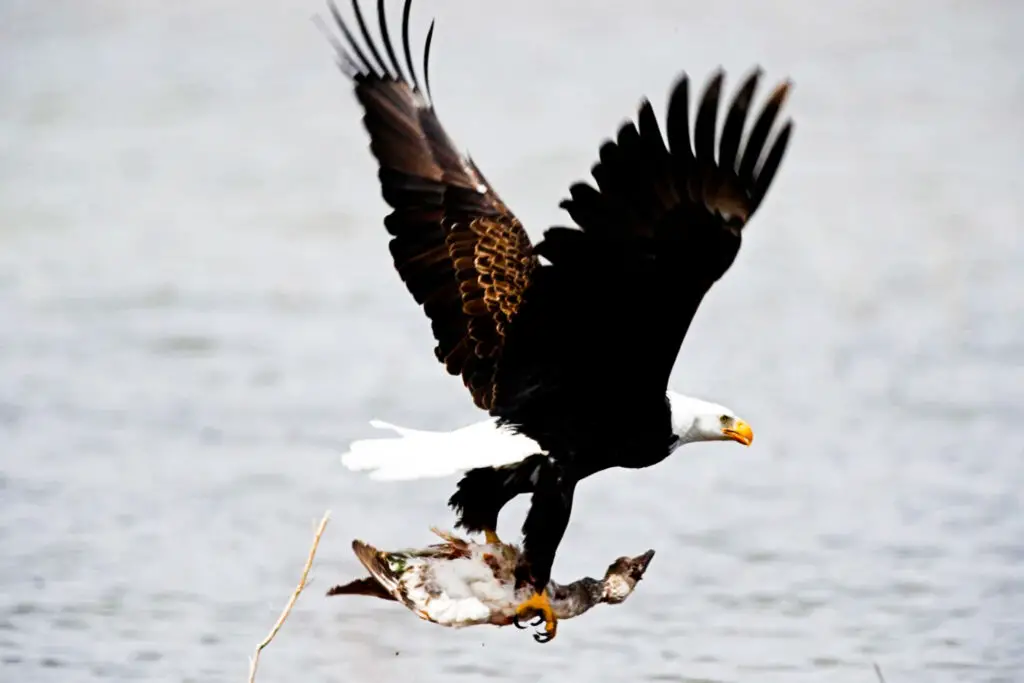
We have reached a key point in this guide: feeding. Birds of prey are predatory animals that eat live and dead animals, almost any kind of creature; they hunt insects, amphibians, mammals, reptiles, and even other birds. In fact, if you have a granivorous bird at home, it could become dinner for an eagle or hawk, so I don’t recommend you to keep it next to pets that it could potentially prey on (rabbits, birds, hamsters, etc).
Meat
Raptors maintain a diet based on fresh or dead meat, from the animals they hunt or carrion. On average, a raptor can hunt between 2 and 3 prey per day, approximately 10 to 20% of its body weight in meat. You can provide fresh chunks of food and live animals, which provide the necessary nutrients and sufficient quantity to satisfy their hunger. I advise you, if you are going to give live animals, consider the species of bird of prey, not all of them eat the same.
In their natural habitat, eagles prefer mammals and their talons are adapted to catch them, some have fish in their diet as well. Meanwhile, owls prefer rodents, lizards, and insects, among other animals. However, you can feed them chicken and other sources of protein from other animals in captivity.
Did you know?
Vultures are slightly less renowned and famous birds of prey than their relatives the eagles, hawks and owls, although they are just as important in the ecosystem. Perhaps because of their reputation as opportunists. Well, the truth is that they eat what others leave behind and contribute to the natural balance. But, one of the great abilities of the vulture is to eat a lot in a short time, if you were to compete with this animal you would lose since it can eat 1 kilo of meat in just one minute.
The health of birds of prey
Here are the five most common diseases affecting birds of prey. Pay attention!
| Health problems | Symptoms and cause | What to do? |
| Avian trichomoniasis | Trichomoniasis is a disease caused by the parasite Trichomonas gallinae, a flagellated protozoan present in the bird’s food. The effects of the pathogen are manifested in the mucosa of the mouth, pharynx, and crop, causing erosion and yellowish plaques with progressive growth. | Check the food you feed your bird and make sure it is fresh. Additionally, if it is not for immediate consumption, keep it refrigerated. If the animal presents the disease, you must go to the veterinarian. |
| Metabolic Bone disease | MBD is a disease caused by poor nutritional management of captive birds of prey. The disease is manifested by insufficient calcium intake or malabsorption of the mineral. | Add food containing sufficient calcium to the bird’s diet. Additionally, consult with your veterinarian about the diet and check if the animal has problems absorbing the mineral. |
| Aspergillosis | It’s an acute or chronic respiratory disease. Aspergillosis is caused by the fungus Aspergillus fumigatus, present in the air and food, generating in the bird, dyspnea, forced, tense and heavy breathing, besides rales, cyanosis (bluish coloration of tissues) and lesions in the intestines. | The bird must have a strong immune system, which you can check periodically with your veterinarian. To prevent this disease, avoid exposing the food to the elements and contaminating it with fungus spores. If it has already been infected, take it to the veterinarian. |
| Pododermatitis | Commonly called “nails” in the paws. This disease occurs as an inflation of the paws caused by an infection, affecting both the sole of the paw and the toes. Abscesses and pressure ulcers can also occur, which can cause irreversible damage. The bird becomes lame and in the worst case, it will stop walking. | To prevent pododermatitis, you must combine several care measures, among them, good nutrition, exercise, periodic revision of the paws, keeping the environment clean and low humidity. As soon as you notice a slight swelling on the sole of the bird’s foot, take it to the veterinarian. |
| Acariasis | External parasites are the most common infectious agents among birds, affecting their plumage and skin. Mites are arachnid parasites that live on the skin without causing problems, but when their numbers increase, they irritate the skin and cause feather loss. | Ensure both the bird and its environment hygiene as mites proliferate in dirt and filth. |
Birds of prey suffer from various diseases often originating from their prey, which transmits viruses and bacteria through their meat. Domesticated captive birds often suffer from infections due to feeding on chickens, pigeons, ducks, turkeys, and other birds. While wild hawks, eagles, and owls are more resistant and can acquire immunity to some of these pathogens.
Birds of prey are amazing animals and require a lot of expertise from their owners. A special pet needs special care. No regrets!
If you are looking for an unconventional pet and realized that raptors are not your thing, here are complete guides on other pet bird species:
